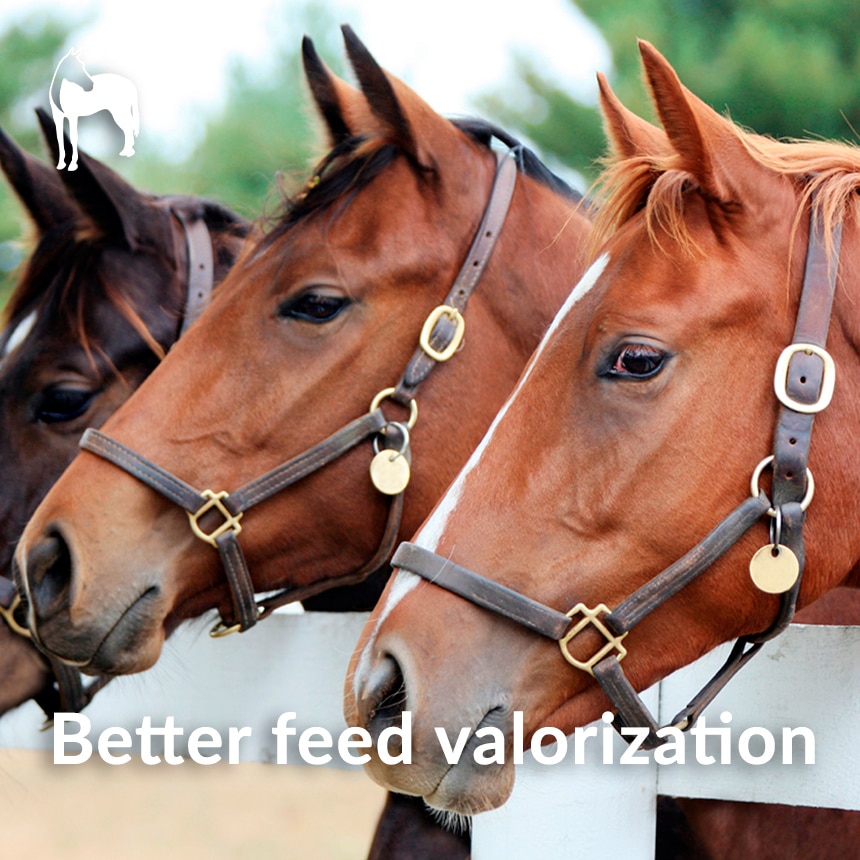Securing digestive health
3 ways to improve digestive health in horses
Sports horses are usually managed in a way that predisposes them to the development of intestinal pathogenic bacteria. Unfortunately, sporting use indeed often goes alongside feeding habits which do not fit with the horse’s physiological needs. This exposes them to a high risk of gastrointestinal disease.
At Phileo by Lesaffre, we provide yeast postbiotics to prevent intestinal disorders and the deterioration of digestive functions in sports horses.
Enriched in more than 20% mannan-oligosaccharides (MOS) and 20% ß-1.3/1.6-glucans, Safmannan® creates a natural shield in the gut by:
• Improving health by reducing pathogen pressure,
• Boosting resistance against intestinal upset by reinforcing the gut barrier
• Contributing to the improvement of intestinal health following an abrupt diet transition

Reduce pathogen pressure
Pathogenic bacteria use specific structure on their outer wall, called the fimbriae (like very fine hairs), to bind with carbohydrates at the surface of gut cells. This adhesion is essential for their proliferation.
The yeast cell wall is composed of mannan carbohydrates, which, as a decoy, enable the yeast to bind with bacterial fimbriae.
The standardized Mannans fraction of Safmannan can therefore be used to efficiently bind pathogenic bacterial in the gut.
Numerous Salmonella strains have indeed been tested to evaluate Safmannan®’s binding properties showing an impressive 81.3% of Salmonella strains were bound.
Reinforcement of gut barrier
MOS are additionally able to protect intestinal mucosa, by enhancing mucin barrier of the brush border and reducing the enterocyte turnover rate. A significant increase in villi height-to-crypt depth ratio can be observed in MOS-supplemented animals, as well as an increase in the number and size of goblet cells relative to villus height.
In studies carried out more specifically with the MOS-rich parietal fraction Safmannan®, diet supplementation results in an increase in goblet cell numbers, thereby promoting mucus secretion and strengthening the intestinal mucosal barrier against pathogens.
Safmannan® also helps to preserve tight junctions’ integrity. Pathogens are thus not able to translocate from the gut into blood.
Better management of dietary transition
Horses are exposed to a lot of diet transition. For example, when Spring arrives, horses are turned out and they need to adapt from a diet that contains a lot of hay to one that contains a lot of fresh grass.
Such a sudden change of diet can lead to colic and laminitis.
Thereby, during diet transition periods in horses, giving Safmannan® is beneficial to gastrointestinal tract care.
• It helps commensal flora to adapt more quickly to the new diet, which might indeed minimize intestinal disturbance and avoid a negative impact on equine health.
• A study showed that Safmannan® contributes to the improvement of intestinal health (p < 0.1) by maintaining normal levels of fecal IgA following an abrupt diet transition.
Q&A
What are mannans and ß-1.3/1.6-glucans?
Mannans and ß-1.3/1.6-glucans are natural carbohydrates existing in the yeast cell walls. Provided that they come selected and properly processed, they confer health benefits when supplemented. They are therefore considered as postbiotics, defined by The International Journal of Molecular Sciences as “bioactive compounds produced by food-grade microorganisms during a fermentation process with proven health benefits”.
What are tight junction (TJs)?
They are a type of cell-to-cell junction that control paracellular transportation and form a physical barrier to regulate physiological homeostasis. One of the TJs functions is to seal the intercellular space of the epithelium. Common equine diseases are related to their degradation, such as colic (dehydration, malabsorption) and skin carcinoma (type of skin cancer in horses) for example. Thus, horses’ health can be compromised because of imperfect formation of TJs. Safmannan helps to preserve their integrity.
What are IgA?
Immunoglobulin A (IgA) is an antibody. IgA have a key role in the immune defense and resistance against infection of mucous membrane. They are the predominant immunoglobulin type found in mucosae. They are involved in the neutralization of the antigens that come from the environment, like food. Thus, IgA is essential to protect the surfaces of gastrointestinal, respiratory and genitourinary tracts. We can measure their level in the feces.
How often should I feed my horses with Safmannan?
Horses can be fed with Safmannan on a daily routine so they can benefit from positive effects of standardized of mannan and beta glucans fractions, regarding the reduction of pathogen pressure, the reinforcement of gut barrier and the intestinal local immunity.












